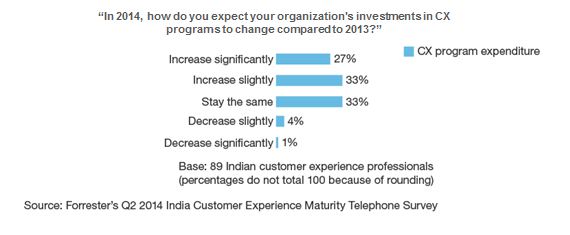Customer Experience Spending Surges In India But Lacks Business Alignment
Forrester’s survey data shows that the vast majority of Indian CIOs (87%) consider addressing rising customer expectations and improving customer satisfaction to be their top business priorities. Soaring customer demand is putting pressure on businesses to invest in customer experience (CX) initiatives. For my recently published report, The State Of Customer Experience Management In India, 2014, we surveyed 89 CX professionals in Indian organizations and asked them about their spending plans for 2014. Here's what we found: 60% of them expect to spend more on CX programs this year.

While this increased spending on CX by Indian organizations is encouraging, their initiatives too often lack alignment with business goals. We asked the same set of CX professionals about their key CX practices and found that 44% don’t regularly model the influence of CX metrics on business outcomes, while 49% don’t consistently consider alignment with CX strategy as a criterion for project funding and prioritization decisions.
These findings highlight the disconnect between organizations’ commitment to boosting CX and the impact of these initiatives on business outcomes. In the long run, this disconnect has two implications for organizations and their CX teams:
- Lack of business alignment with soaring customer demands will result in dissatisfaction and churn. While business investment in CX is growing in India, initiatives that don't align with desired business goals will fail to result in desired business outcomes, thus creating a gap between market demand and the business offering.
- Despite their potential, many CX practices are currently set up for failure. With Indian organizations betting big on CX to drive market differentiation, CX teams are under immense pressure to perform. If a CX team fails to prove its business potential, it stands to lose value in the eyes of the C-suite — jeopardizing both its future funding and its potential for growth within the organization.
To avoid the failure of your CX initiatives and ensure the success of CX-related business investments, CX professionals must clearly align their CX initiatives with both short-term goals (i.e., the desired result of an initiative) and long-term goals (i.e., business outcomes). Even after implementation, you must regularly evaluate an initiative's impact on goals to ensure it is on track; identify the loopholes early; and take corrective measures along the way. Read my report to understand and identify the gaps that organizations must avoid to ensure CX program success.